FACE – The flat surface at the forward end of a graver that
plows up a metal chip from the object being engraved.
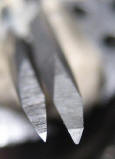
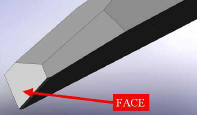
|
FACE ANGLE – The grind angle of a graver’s face as measured in
degrees from a perpendicular. Most gravers use a face of from 45 to 65
degrees however they may be sharpened as steep as 90 degrees. Also
known as rake angle.
|
FANTASY ENGRAVING – A style of engraving multiple figures in
an interwoven collage. This design concept was pioneered by gun
engraver Manrico Torcoli of Gardone, Val Trompia, Italy and is in use
by top engravers internationally today. Fantasy engraving usually
combines human (often nude females) and animal figures in a sort of
dreamscape vision as contrasted with traditional arms engraving where
figures are engraved in traditional poses within a vignette as found in
game scenes or neoclassical motifs.
|
FEGA – See: FIREARMS ENGRAVERS GUILD OF AMERICA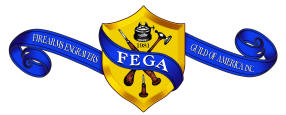
|
FENCES – The breech balls of a side by side shotgun or rifle.
Also known as the detonating.
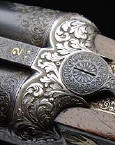
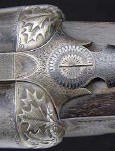


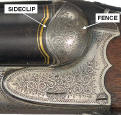
Pictured are fences engraved with sculpted relief scroll, relief
chiseled holly leaves, relief laurel leaves, relief oak leaves with
gold inlayed acorns, and English scroll engraved fences with side clips
and gold inlayed barrel bands.
|
FESTOON – A motif representing a decorative chain of foliage or
fruit hanging between two points.


Pictured are illustrations of classic festoons.
|
FEUILLES D’ACANTHE – French for acanthus. A decorative leaf
design used in a variety of ways by arms and bank note engravers as
well as wood carvers. The acanthus plant is common to the Mediterranean
region. German engravers refer to acanthus decoration as "Arkantuslaub.”

Pictured are the fences of a Belgian shotgun with sculpted feuilles
d'acanthe.
|
FFL – The abbreviation for a Federal Firearms License (USA). In
the United States, anyone who works on firearms as a profession must
have a Federal Firearms License including engravers. Engravers are
however allowed to work on unserialized parts of a gun such as side
plates, stock ovals, or detachable back straps without a license. Even
hobby engravers are not allowed to keep another person’s gun in their
shop for engraving over night without an FFL but they are allowed to
work on their own guns without an FFL.
|
FIGURE – Engravers use this term to describe a single subject to
be engraved or inlaid, such as a human being, an animal, or a
mythological creature. 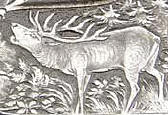
|
FILIGREE – Delicate ornamental work of fine silver, gold, or
other metal wires, esp. lacy jewelers' work of scrolls and arabesques.
Engravers sometimes refer to pierced work as filigree.
|
FINISH – The final treatment given to the metal parts of an item
after engraving. On steel, some finishes are bluing; browning; plating;
(including nickel, silver, or gold); graying (including French gray,
satin gray, frost gray, and acid gray); coin finish, and Parkerizing.
Engravers who practice their trade on precious metal use the term
“finish” to describe the degree or type of polish to the surface. Arms
engravers, working on steel, must be able either to apply the
appropriate finish or subcontract the finish work to a qualified
gunsmith.
|
FIREARMS ENGRAVERS GUILD OF AMERICA - The Firearms Engravers
Guild of America (FEGA) was formed by firearms engravers as a
non-profit organization to perpetuate the art of firearms engraving. In
1980, twenty-one engravers from across America met in Las Vegas,
Nevada. This informal meeting was the catalyst for the formation of the
Firearms Engravers Guild of America (FEGA). In 1981, the group met
again in Houston, Texas and thirty-six engravers formally voted the
guild into existence. FEGA was incorporated as a non-profit in the
State of Texas. Frank Hendricks was elected as the first President of
the Guild. The Guild currently has over 500 members, some of which are
international members. The current president of the Guild is Rex
Pederson of Ludington, Michigan. The website of FEGA can be found at
this address:
http://www.fega.com/
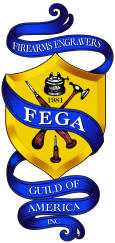
|
FISH FIN – A decorative motif, usually used for border
decoration, made popular by 19th century arms engravers, but used much
earlier. Resembles the fin of a fish.
|
FLACHSTICHGRAVUR – German: Literally “flat pass engraving.”
German speaking engravers use this term to denote engraving that is not
in relief such as line cut and banknote scenes and figures.
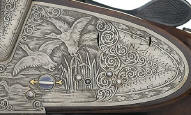
Pictured is an example of flachstichgravur on the sidelock of a German
O/U shotgun. Note German scroll, wheat chaff border and gold inlayed
arrow cocking indicator.
|
FLARE CUT – A technique of engraving ornamentation, particularly
scrollwork, whereby a flat or square graver is used to make a beveled,
flaring primary cut which is next back cut with an opposing bevel that
creates a sculpted look to the design. Also known as transition cut or
double bevel cut.
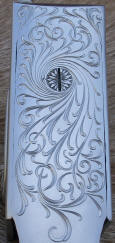
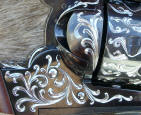
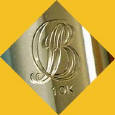

Illustrations depict the floor plate of a .410 shotgun and revolver
flare engraved by Roger Bleile as well as ciphered initials and lip
plate engraving on a gold flute flare engraved by Steve Lindsay.
|
FLAT GRAVER – The flat graver is one of the two most common
graver shapes used by hand engravers, the other being the square
graver. The flat graver is shaped similar to a wood chisel. It is used
extensively in western bright cut engraving as well as in flare cut
engraving. The flat graver is also used for chiseling out background.
Flat gravers are produced by a number of manufacturers in standard,
numbered widths from #36 to #49.


Illustrations depict the flat graver in profile and the cutting face of
the flat graver.
|
FLATWARE – As referenced by engravers, flatware is a collective
term for silver forks, knives, and spoons as well as special serving
implements of the table. The engraving of flatware is usually limited
to ciphers, initials, or monograms. 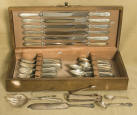
|
FLOORPLATE – The external portion of a self-contained box
magazine, in a bolt action rifle, that acts as a base plate for the
follower spring. On double barreled shotguns and rifles, the floor
plate is inset into the bottom portion of the receiver. Floorplates are
a commonly engraved portion of a firearm, even when the other parts are
left unengraved.
_small.JPG)
Shown is the engraved floorplate of an Austrian Franz Sodia O/U
shotgun.
|
FLORAL – A style of decoration that uses more flowers and leaves
than scrollwork and depicts spiral vines.

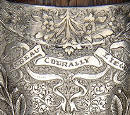
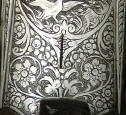
|
FLORENTINE –1. As used in the decoration of jewelry, the term
means to apply a rough, shaded texture to the piece with a liner. 2. A
type of textured background surrounding the vines and leaves of scroll
or floral designs. 3. Another term for floral engraving.
|
FLY OUT – An engraver’s term to denote a slip with the burin or
chisel.
|
FRETWORK – A design of usually angular interlocking lines,
originating in ancient Greece. Engravers use fretwork for cut or inlaid
borders. Also known as Grecian frets.
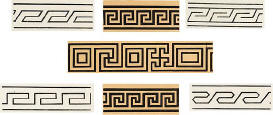
|
FURNITURE – The metal parts of a rifle or shotgun (especially
muzzle loaders) other than the barrel or receiver. The furniture may
include the trigger guard, buttplate, nose cap, ramrod thimbles and the
sideplate. Furniture is often found engraved on ornate American long
rifles of the 18th and early 19th centuries.
|